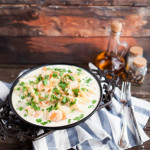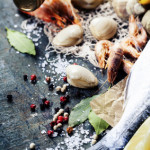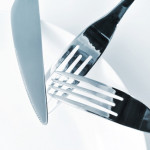Hungry for halibut or craving clams? There’s an easy way to prepare fish and seafood to perfections. Fish is ready when you can flake it easily with a fork. Shrimp and shellfish are done when they are opaque in color.
Bake: Best for fish fillets. Baking or roasting fish is an easy, hands-off method, especially good if you have a crowd to feed. As with any fish cooking technique, follow the recipe to avoid overcooking.
Wrap: Best for any fish fillet and shellfish. Cooking fish in foil is one of the most versatile ways to prepare fish, resulting in moist, flavor-packed dishes. And because you can load up on tasty ingredients, like herbs, citrus and spices, it’s a great way to cut back on fat and sodium without sacrificing flavor. Plus, cleanup is a breeze.
Poach: Best for any fish fillet and shellfish. Poaching simply means gently cooking the fish in liquid, such as water, broth, beer, or wine. It ads subtle flavor without drying out the fillets or adding any extra fat. To poach, simply cover the fish or seafood with liquid and bring to a simmer, just don’t let the liquid boil. You’ll only need a few minutes for your fish or seafood to be ready. You can also use the poaching liquid as a base for a sauce when you’re done.
Broil: Best for thick and meaty fish fillets, shrimp, and lobster tails. This method is especially good when you want to quickly bake fish and seafood. This is also a good method when you don’t have access to a grill or you’re adding a glaze. To make sure it doesn’t cook or brown too quickly, cook the fish at least 6 inches away from the broiler and watch carefully.
Steam: Best for clams and mussels. The traditional cooking method for clams and mussels, steaming is an easy way to add delicate flavor quickly without overcooking. Just add the seafood to a lidded saucepan with a little liquid like beer, wine, or broth, cover and bring to a simmer until the shells open up. Discard any that don’t open. You can also steam lobster, but it’s worth checking to see if your store’s fish department will steam lobsters for you.
Sear: Best for scallops, shrimp, and fish fillets. Use this cooking method for fish with a crisp, browned crust and a tender interior. Use a non-stick pan if possible and add a little oil before adding your fish, in batches if necessary, Don’t crowd the pan. Cook without stirring or turning for 2 to 3 minutes to brown the fish and crisp up any breading.
Grill: Best for any fish fillet or shellfish. Once grilling season rolls around don’t forget to add fish, shrimp, and even clams and mussels to your summer menus. Fish fillets take well to grilling and are easy to flip. Use a grilling basket for anything that might slip through the grate. Don’t forget skewers, which are the perfect way to grill shrimp.
“Work With What You Got!”
©Tiny New York Kitchen © 2020 All Rights Reserved
It’s Cold Outside And Time To Make Soup
Seafood
Keep your seafood fresh with safe handling and cooking tips.
Selecting Seafood
The first step in putting the best seafood on your plate is making sure that you put the best seafood in your shopping cart. Make the best choices at the store and you’ll enjoy great taste at the table every time.
When you’re shopping, make seafood the very last thing you pick up before you check out. Make sure to place it in an insulated bag for your trip home.
When purchasing clams and oysters in their shells, make sure they are alive. Shells of live clams and oysters may open naturally, but will close tightly when tapped, indicating that they are alive. Throw away any dead ones.
Fresh whole fish should have a shiny surface with tightly adhering scales, gills that are deep red or pink, free of slime, mucus and off-odor, and milk, briny aroma, similar to the ocean.
Fresh steaks, fillets, and loins should have a translucent look, fresh that is firm and not separating and a mild briny odor, similar to the ocean.
Handling Seafood
Shore to store is only one leg of the journey. It’s important to continue following safe handling recommendations once you take your seafood purchase home.
If your seafood is frozen make sure to thaw seafood in the refrigerator. Never thaw at room temperature.
Wash your hands with hot soapy water before and after handling raw seafood.
Thoroughly wash containers that held raw seafood before using them again.
Cooking Seafood
Now that your seafood is home safely, it’s time to get cooking.
Make sure that you cook fresh fillets and shellfish 1 to 2 days after purchasing.
Keep seafood refrigerated until it’s time to cook.
A general rule for baking and broiling fish is 10 minutes per inch of thickness at 400 to 450 degrees.
Fish is done when the flesh becomes opaque and flakes easily at the thickest part.
Scallops, clams, oysters, and shrimp become opaque and firm when fully cooked. Don’t overcook as this will result in loss of moisture, which affects texture and taste.
To boil, place shrimp and scallops in a large pot of boiling water (four cups of water per pound of meat) and simmer three to five minutes.
Broiled scallops and peeled and deveined shrimp will be cooked in 3 to 5 minutes.
Broiled shucked clams and oysters will be cooked in 3 to 5 minutes.
Oysters and clams should be steamed until their shells open completely. Throw away any that do not open.
Most seafood should be cooked to an internal temperature of 145 degrees. Consuming raw or undercooked seafood or shellfish may increase your risk of foodborne illness, especially if you have a medical condition.
“Work With What You Got!”
© Victoria Hart Glavin Tiny New York Kitchen © 2016 All Rights Reserved
Perplexing Foodstuffs
There are those foods that can be rather difficult to figure out how to eat without looking like you were born in a cave. Here are some useful tips for properly eating perplexing foodstuffs.
Artichokes
Pluck off artichoke leaves and scrape the tender part (not the prickly point) between your teeth (preferably after dipping in melted butter). Work your way to the delicate inner leaves, and then use a knife to cut off the remaining small leaves and feathery innards. Cut the artichoke “heart” into bite-sized pieces and eat with a fork.
Asparagus
Eat asparagus with your fingers if served raw as crudités. Eat with a fork and knife if served with dinner.
Bread
Break bread into bite-sized pieces, and butter it or dip it into olive oil just one piece at a time.
Crab (Soft-Shelled)
Eat entire crab, including shell, either in sandwich form or using a fork and knife. Remove inedible pieces from your mouth with a fork.
Fajitas
Place meats, vegetables, and other fillings on a flat tortilla. Roll up and use your fingers to eat fajitas from one end.
Fondue
Spear bread, vegetables, or fruit with a fondue spear and dip into cheese or sauce. Remove food from spear using a dinner fork, and eat from a plate. DO NOT double dip. Spear uncooked meat cubes and place spear into fondue broth or sauce. When cooked, transfer meat to a plate using a dinner fork and cut into smaller pieces to eat.
Lobster
Wear a lobster bib to avoid fishy splatters, Crack shells with shellfish crackers and extract meat with a small fork or pick. Cut larger pieces with a knife, and eat with a fork after dipping in melted butter. Clean your hands by dipping fingers into finger bowls, and use lemon (if provided) to cut extra grease. Dry your hands with your napkin.
Peas
Use a knife to push peas onto a fork. Do not mash peas before eating, or eat peas from a knife.
Raw Shellfish
Use a small fork to extract mussels, clams, or oysters from the half-shell. Season with fresh lemon or cocktail sauce. In informal settings, you may quietly slurp shellfish from shells.
Soup
Using a soup spoon, spoon soup away from your body and then quietly sip from side of spoon. Tilt bowl away from you to spoon up remaining drops.
Spaghetti
Twirl pasta with fork tines into bite-sized portions, and allow any dangling pieces to fall back onto your fork. You may also rest fork tines against the bowl of a spoon while you twirl pasta.
Steamers
Extract clam from shell using a small fork, and use a fork and knife to remove inedible neck. In informal settings, it is permissible to use fingers.
“Work With What You Got!”
© Victoria Hart Glavin Tiny New York Kitchen









